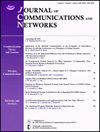通信系统量子技术特刊
IF 3.2
3区 计算机科学
Q2 COMPUTER SCIENCE, INFORMATION SYSTEMS
引用次数: 0
摘要
量子技术有可能彻底改变传统技术及其在通信网络和移动领域的新兴应用。这种潜力有望随着量子计算设备的进步而增长。目前,量子器件处于嘈杂的中尺度量子(NISQ)水平,只能支持几百个物理量子位。虽然这些设备在规模上仍然受到限制,但早期的容错量子硬件能够展示量子优势,即在特定的计算任务中超越经典同类的能力。这种能力对于增强自主和分布式系统的协调至关重要,例如低地球轨道(LEO)卫星、自动驾驶车辆和超连接6G通信网络所需的复杂基础设施。特别是在人工智能(AI)研究领域,量子算法、量子优化和量子机器学习(QML)中使用的参数化量子电路可以以更少的参数和计算资源实现经典神经网络架构的各种功能。这可以大大减少当前大规模经典神经网络框架的延迟和内存限制,包括基于扩散的生成计算机视觉算法和大型语言模型。根据目前的量子计算机发展路线图,量子比特的数量预计将大幅增加,超过nisq的时代将在2026年左右出现。这突出了早期贡献的必要性,以探索量子算法和QML对新兴通信系统设计和未来应用的潜在影响。为了释放量子算法和QML的全部潜力,本期特刊关注量子算法和QML原理、算法和用例,以寻求在通信系统中基于QML的系统架构、协议、资源管理、纠错和其他技术的各个方面的原创贡献。此外,人们对应用经典人工智能技术解决量子计算和计算中的问题也越来越感兴趣,例如量子软件工程、量子电路设计和优化量子优化算法。尽管学术界和工业界对该领域都很感兴趣,但仍存在许多重要问题。本期《JCN》特刊介绍了5篇高质量的论文,它们被分类为(i)理论、(ii)通信和网络、(iii)应用。下面,我们将介绍本期特刊的主题、章节类别和相应的论文。本文章由计算机程序翻译,如有差异,请以英文原文为准。
Special issue on quantum technologies for communication systems
Quantum technologies hold the potential to revolutionize classical technologies and their emerging applications in communication networks and mobility. This potential is expected to grow alongside the advancement of quantum computation-capable devices. Currently, quantum devices are at the noisy intermediate-scale quantum (NISQ) level and can support only a few hundred physical qubits. While these devices remain constrained in scale, early fault-tolerant quantum hardware is capable of demonstrating the quantum advantage, the ability to outperform classical counterparts in specific computational tasks. This capability is essential for enhancing coordination of autonomous and distributed systems, such as low Earth orbit (LEO) satellites, autonomous driving vehicles, and complex infrastructure required by the hyper-connected 6G communication networks. Especially in artificial intelligence (AI) research domains, parameterized quantum circuits used in quantum algorithms, quantum optimization, and quantum machine learning (QML), can implement various functionalities of classical neural network architectures with significantly fewer parameters and computation resources. This can substantially reduce the latency and memory constraints of current large-scale classical neural network frameworks, including diffusion-based generative computer vision algorithms and large language models. According to the current roadmaps for quantum computer development, the number of qubits is expected to greatly increase, and the beyond-NISQ era is set to emerge approximately by 2026. This highlights the need for early contributions to explore the potential impact of quantum algorithms and QML on emerging communication system design and future applications. Towards unleashing the full potential of quantum algorithms and QML, this special issue focuses on quantum algorithms and QML principles, algorithms, and use cases to seek original contributions to various aspects of QML-based system architectures, protocols, resource management, error correction, and other technologies in communication systems. Furthermore, there is also an increasing interest in applying classical AI techniques for solving problems within quantum computing and computation, such as in quantum software engineering, quantum circuit design, and optimizing quantum optimization algorithms. Despite significant interest in this field from both academia and industry, many important questions remain. This special issue of JCN presents five high-quality papers which are categorized under (i) theory, (ii) communications and networks, and (iii) applications. In the following, we will introduce the topic section categories and corresponding papers included in this Special Issue.
求助全文
通过发布文献求助,成功后即可免费获取论文全文。
去求助
来源期刊
CiteScore
6.60
自引率
5.60%
发文量
66
审稿时长
14.4 months
期刊介绍:
The JOURNAL OF COMMUNICATIONS AND NETWORKS is published six times per year, and is committed to publishing high-quality papers that advance the state-of-the-art and practical applications of communications and information networks. Theoretical research contributions presenting new techniques, concepts, or analyses, applied contributions reporting on experiences and experiments, and tutorial expositions of permanent reference value are welcome. The subjects covered by this journal include all topics in communication theory and techniques, communication systems, and information networks. COMMUNICATION THEORY AND SYSTEMS WIRELESS COMMUNICATIONS NETWORKS AND SERVICES.

 求助内容:
求助内容: 应助结果提醒方式:
应助结果提醒方式:


